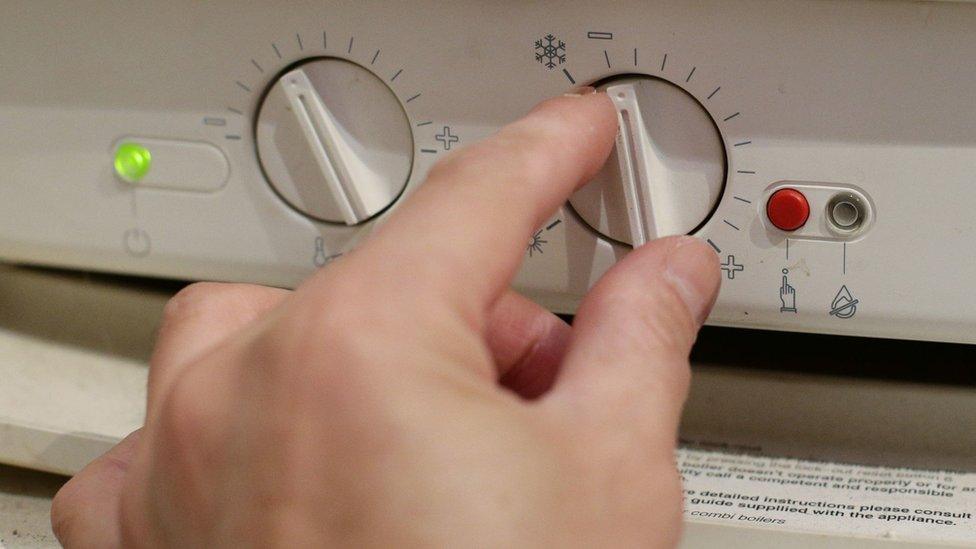Ignore hype over hydrogen heating, government told
- Published

Environmentalists are warning the government to ignore what they call “hype” over the use of hydrogen to provide heat.
New natural gas boilers will be phased out next decade because their emissions add to climate change.
Oil and gas firms are pushing for so-called “blue” hydrogen to be used to provide heat instead.
But environmentalists say electric heat pumps are a much better option for most homes.
In a letter to Business Secretary Kwasi Kwarteng on Friday, groups including climate think tank E3G, WWF, and Greenpeace urged the government to drop funding for “blue” hydrogen.
They said that it appears to be environmentally-benign, but really it’s not, external.
What is blue hydrogen and why is it being promoted?
Most homes are heated by gas, and the domestic gas market is worth £28bn a year.
The push to use hydrogen as a substitute comes from the oil and gas giants who supply the fuel; the firms that make the boilers; and gas network operator Cadent.
Most investment so far is going into “blue” hydrogen, produced by splitting natural gas at high temperatures.
This process does produce carbon emissions, but these can be captured by a chemical solvent and forced into underground rocks using carbon capture and storage (CCS).
The Hydrogen Taskforce, an industry body, wants hydrogen blended into the existing gas network to reduce emissions overall. And it wants all boilers to be made to be “hydrogen-ready”.
If blue hydrogen involves capturing CO2, what’s the problem?
“Blue” hydrogen is much better for the climate than natural gas – but green groups writing to the government say it’s incompatible with a zero-carbon Britain.
That’s because fracking for the natural gas to produce hydrogen creates leaks of methane – a potent planet-heating gas.
Emissions are also created in the exploration for gas and its transport.
What’s more, many environmentalists don’t trust the carbon capture technology essential for blue hydrogen because it’s been touted for decades as a planetary saviour, but is still not locking up carbon dioxide at scale.
They ask why consumers should face the extra cost of hydrogen-ready boilers when the advisory Climate Change Committee projects that only 11% of homes will eventually run on hydrogen.
This minority of hydrogen-heated homes is expected to be in the north east of the UK, to capitalise on the local wind energy industry producing “green” hydrogen.
So, what’s the future role for “green” hydrogen?
“Green” hydrogen is an environmentalist’s dream – using surplus electricity produced on stormy nights by wind farms to liberate hydrogen from water using electrolysis.
It’s a way of storing energy.
This “green” hydrogen is expensive and the process is inefficient – but it does produce genuinely clean hydrogen, and industry experts agree that there’s huge scope for cost reductions from innovation.
Today’s letter argues that any precious “green” hydrogen should be used to fuel industrial processes needing huge amounts of heat, not to heat homes.
What’s driving the blue vs green debate?
Until a few years ago hydrogen was not seen as a significant technology for combating climate change.
But a realisation of the need for energy storage and industrial-grade heat driven by business enthusiasm has pushed it up the political agenda around the world.
Mr Kwarteng, whose portfolio also includes energy, will shortly publish a hydrogen strategy.
He's being advised by the government's Hydrogen Taskforce, which is funded by Shell, BP and Cadent, among others.
And a recent parliamentary question showed that around 75% of public hydrogen investment in the industrial decarbonisation strategy has gone to the “blue” type.
What does the government say?
The government says it want to support both blue and green hydrogen, and is working on a standard to define “low-carbon hydrogen”.
A government spokeswoman told BBC News: “Scaling up the production of low-carbon hydrogen is a key part of our plan to end the UK’s contribution to climate change by 2050.
“The government has already supported a range of green hydrogen projects, including Project Dolphyn, where floating offshore wind is combined with an electrolyser, external, and ITM Power’s Gigastack project – the world’s largest electrolyser manufacturing facility.”
The spokeswoman added: “The Hydrogen Advisory Council includes representatives from industry, academia and the public sector, with expertise in both blue and green hydrogen.”
What does the blue team say?
“Blue” hydrogen campaigners back the government’s plan to continue supporting both technologies.
They agree the costs of “green” hydrogen will fall, but say there’s a key role for blue hydrogen to provide hydrogen at relatively low cost in the short to medium term.
The Hydrogen Taskforce wants rules changed to "enable hydrogen blending into the gas grid and take the next steps towards 100% hydrogen heating through supporting public trials and mandating hydrogen-ready boilers by 2025."
It says both types of hydrogen will be needed.
What does the green team say?
The organisations behind the letter to government include the climate think tank E3G and the green groups WWF and Greenpeace.
They say if the government embraces “blue” hydrogen, it would lock fossil fuels into the UK energy mix and ultimately cost customers more.
They want governments worldwide to focus on energy efficiency and heat pumps for homes rather than promoting the blending of hydrogen into the gas grid or mandating of hydrogen- ready boilers.
Juliet Phillips from E3G said: "Hope in hydrogen must not be clouded by hype, particularly when it comes to heating our homes.
"The government mustn’t block near-term progress on cheaper, more effective and readily available solutions of energy efficiency, heat pumps and renewable heat networks.”
- Published14 May 2021

- Published12 May 2021

- Published6 February 2021
